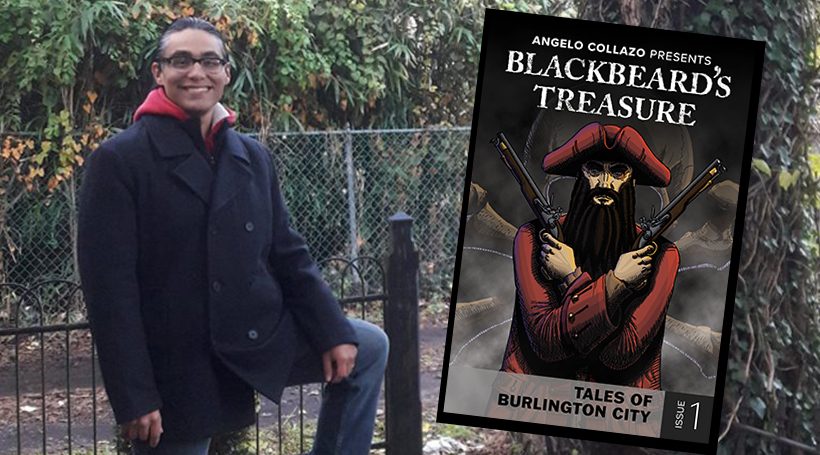Angelo Collazo next to a black walnut tree on Wood Street
Not much can grow near a black walnut tree. Its roots twist through the soil, releasing poison that proves deadly to many rival plants in its path. For that reason, each tree stands alone, making it easy to recognize should you need to return to a specific spot someday. As legend has it, a pirate’s treasure is buried under one of those trees in the city of Burlington.
Blackbeard, an English pirate who controlled the Caribbean Sea in the early 1700s, docked his ship in Burlington City in 1717 loaded with gold, jewels and riches in need of safe-keeping. That’s the legend, at least. What may have happened next is the subject of “Blackbeard’s Treasure: Tales of Burlington City,” a comic book written by Burlington resident Angelo Collazo.
This is Collazo’s first comic, and it’s personal to him. Not long after he moved to Wood Street about a decade ago, Collazo heard the legends of Blackbeard’s treasure – finding out for the first time that the mythic booty could be underfoot in his neighborhood.
“For years it stuck in the back of my mind,” says Collazo, a professional computer animator. “I couldn’t stop thinking about the fact that one of the most notorious pirates in history may have buried treasure on my block.”
He sat on the idea of making a comic book about Blackbeard’s adventures for years, finally deciding to write and illustrate the story during the pandemic. His version of the legend mixes reality with fantasy. It’s a fact that Blackbeard and his crew operated along the Eastern Seaboard, where they captured 6 or 7 merchant ships along the Delaware Bay in 1717, according to history books.
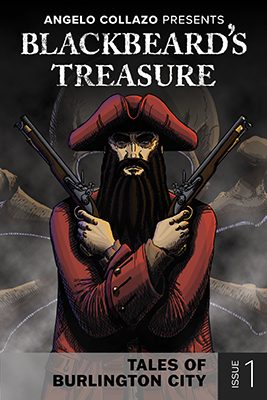
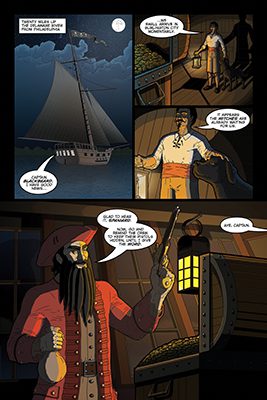
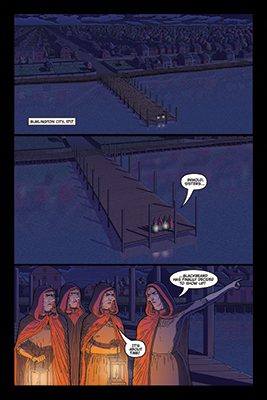
Collazo’s comic book version of events features a fictional meeting between the notorious pirate and a coven of witches in the dead of night. In his telling, Blackbeard strikes a deal with the witches before he buries his treasure beneath a black walnut tree in town. But after burying the treasure – and killing one of his own men – he double-crosses the coven, which leads to his downfall.
As Collazo sees it, whether the Blackbeard tale is true or local lore is beside the point. Fact or fiction, it launched him on a years-long quest to tell the story in comic book form. It was slow going at first, but when the Covid lockdowns hit, he decided he had no excuse not to bury himself in historic artifacts. And what he found was fascinating.
“Pirates were actually a very welcomed part of many communities because they were able to bring cheap, untaxed goods to land,” says Collazo. “A lot of them were actually legal pirates in the beginning. During wartime, as long as you had a license it was perfectly legal to go attack another ship and steal their goods. The problem is, when the war was over, these guys had become accustomed to this method of making a living, and they wanted to keep that up.”
He also discovered, to his surprise, that buried pirate booty really wasn’t all that common.
“Movies make it seem like pirates buried treasure all the time, but that’s not necessarily true,” says Collazo. “These men knew that, because of their lifestyle, they weren’t going to live long, so it’s not like they had a 401k plan. They were more likely to blow it on a weekend of brothels and booze and gambling than bury it for later. That’s part of what makes this legend so interesting.”
Collazo combed through documents looking for any and all evidence that Blackbeard (whose real name is thought to be Edward Teach) had indeed dropped anchor off the coast of Burlington City. He found letters written by British naval commanders that confirmed a sighting of Blackbeard near the Cape May coast. He even found news clippings about a human skull unearthed in the early 1920s under a black walnut tree that was thought to be where Blackbeard buried his treasure. The tree is 2 blocks from Collazo’s home – although it was never confirmed whether the skull was real or just a publicity stunt, Collazo says.
While these were reliable documents, it was the legends that interested him most. The comic is based on an old witch’s tale he found in a book called “Historical Collections of the State of New Jersey,” printed in 1844.
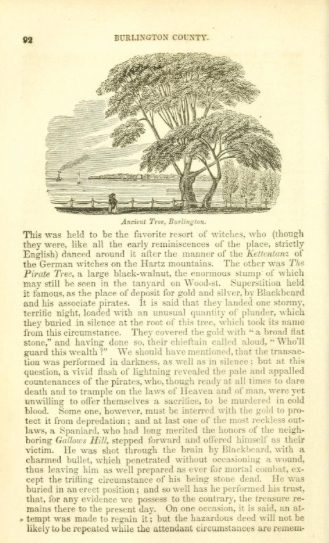
An account of the Blackbeard tale in “Historical Collections of the State of New Jersey,” published in 1846
“It’s 4 witches reciting a poem about seeing Blackbeard come to Burlington County to bury his treasure with a guy named Spaniard,” says Collazo. “According to them, Blackbeard came to a black walnut tree carrying a gun loaded with a magic musket ball. Anyone killed by that musket ball would have his soul tethered to that spot for the rest of eternity to guard the treasure Blackbeard had buried there.”
That poem alone led him down a rabbit hole of questions. Where had Blackbeard gotten that magic musket ball? From the witches, surely, he thought.
As the poem tells it, after burying his treasure safely beneath the earth, Blackbeard killed Spaniard, a member of his crew, to stand guard over the riches. Then, he reloaded his musket and tried to shoot the witches, who placed a curse on him.
“They sang: ‘Away! Away! The night is foul, but fouler by far are ye! The storm is fierce, but fiercer by far is your terrible destiny!’” says Collazo. “The song goes on to successfully predict that his ship would sink, he’d be destroyed, and he’d go to hell.”
In Collazo’s comic book, Blackbeard does shoot Spaniard with the witches’ magic musket ball. Then he turns the musket on the witches, but when the gun smoke clears, the witches are gone. In their place stands the ghost of Spaniard, who informs his boss that the witches have placed a curse on him and his crew. Both Blackbeard and the spirit look up in the tree to see ghostly figures of each and every member of his crew, hanging from the branches. The warning was clear: this would be their fate within the year to come.
Historically speaking, Blackbeard and his crew did meet a tragic end, says Collazo. The following year, 1718, Blackbeard was decapitated in a bloody battle on an island off the coast of North Carolina. Ten of his crew members were killed alongside him in battle, and of the 15 that were captured and tried by the British colonial authorities, 13 were found guilty and hanged. “Could it have been the witch’s curse or just a coincidence,” he asks. “I like to think it truly was the curse.”
“Blackbeard’s Treasure: Tales of Burlington City” has yet to be released in print, but you can find it online at blackbeardcomic.com.
Whether the tale is true or not, who’s to say, says Collazo – his version, at least, neatly ties together facts with legend.
But if it is true, the treasure supposedly lays untouched to this day, beneath a black walnut tree, waiting for a pirate who will never return.


